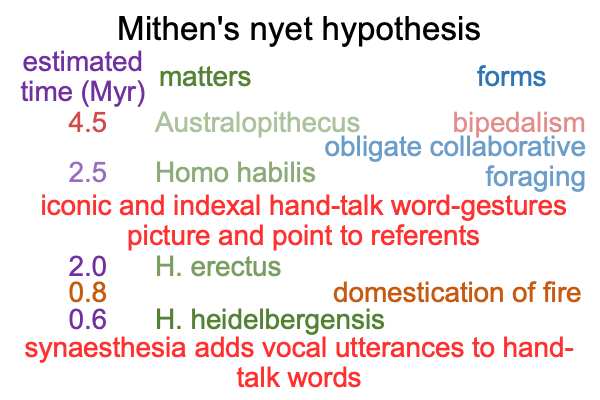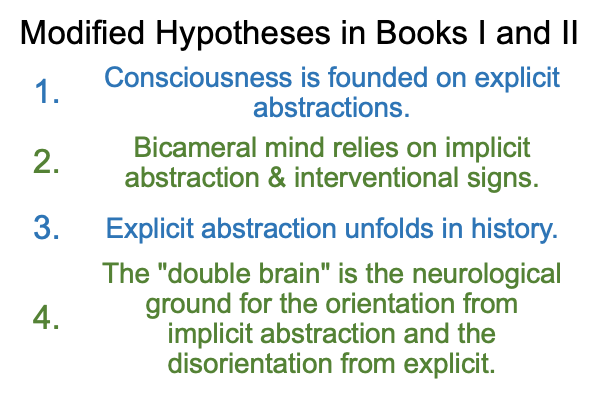0321 Let me briefly summarize.
0322 Looking at Steven Mithen’s Book (2024) “The Language Puzzle” (appearing in Razie Mah’s blog in September 2025) reminds me of an old book, written in 1976, by a professor of psychology teaching at Princeton, Julian Jaynes, titled The Origin of Consciousness in the Breakdown of the Bicameral Mind.
Despite Mithen’s conscious analysis of many modern scientific disciplines investigating the nature of language,Mithen’s text contains clues to a hypothesis that is explicitly ruled out by the analysis itself. I call it the “nyet” hypothesis, because, when a Russian says, “Nyet”, the Russian means “no”, but the word, “nyet”, to the speaker of American English, sounds like “not yet”. Mithen’s conscious argument tells his own bicameral mind, “Not yet.” But, that does not stop his bicameral mind from providing clues to the question that Mithen unwittingly addresses and its scientific answer.
0323 Mithen’s subjective consciousness asks, “How do the jigsaw puzzle pieces of current research into the nature of language (as speech-alone talk) fit together?”
Mithen’s bicameral mind asks, “If we currently practice speech-alone talk and if the gestural origins of language makes sense, then how does speech get added to fully linguistic hand-talk in human evolution?”
0324 The answer is through synaesthesia, as seen in the following figure.

0325 To start, protolinguistic hand-talk is an adaptation to the social circle of the team (15) from the start of bipedalism to the domestication of fire. The team is the social circle that constellates due to obligate collaborative foraging (for more details see Comments on Michael Tomasello’s Arc of Inquiry (1999-2019) by Razie Mah, available at smashwords and other e-book venues).
Hand-talk works through pantomime and pointing. Manual-brachial images and indications become routinized as gesture-words.
0326 Hand-talk in teams is protolinguistic because it is entirely devoted to sensible construction (corresponding to content and situation levels of the scholastic interscope). That does not mean that social construction is not evolving as an adaptation to the social circle of the team. Indeed, social construction is adapting, giving us the innate expectation that words picture or point to their referents as well as an innate social contract based on direct and indirect reciprocity, even altruism. By the time that Homo erectus starts to domesticate fire, these expectations are built into our bodies and minds.
0327 Once fire is domesticated, cooking by fire changes everything. The number of teams multiplies, because foods that are otherwise indigestible become delicious and nutritious when fully cooked. The focus of natural selection shifts from teams (15) to the team of teams, the community (150). Communal eating creates the conditions where hand talk is no longer expressed only in teams. Hand-talk becomes fully linguistic as it adapts to the new communal venues of day-time talk and night-time talk.
0328 Communal day-time talk occurs during gatherings of the community (150), mega-band (500) and tribe (1500). The voice is recruited for synchronization through communal singing. Add the inducements of sexual selection and the voice comes under voluntary neural control.
Fully linguistic hand-talk is used during these gatherings for social construction. Social construction is necessary to promote harmony among family (5), friends (5), teams (15), bands (50), communities (150), mega-bands (500) and tribes (1500). Fully linguistic hand-talk creates novel cognitive spaces through grammatically correct counterintuitive statements, such as the character [image RAVEN][image MAN], whose adventures as a trickster offer important warnings, suggestions and life lessons.
0329 During the era when fire is being domesticated, Homo heidelbergensis evolves with fully linguistic hand-talk, nascent spiritual awareness, and day-talk and night-talk. The Neanderthal and the human lineages separate at this point, around 600kyr (thousands of years ago).
0330 What about communal night-time talk?
After hearths are common, around 400kyr ago, the voluntary neural control of the voice offers a solution to difficulties in decoding fully linguistic hand-talk in campfire settings. A cultural habit begins by imagining which sound fits each hand-talk word. Such imagination characterizes synaesthesia. Once vocal utterances routinely adorn hand-talk, once the Wernicke’s area on the right trains the Wernicke’s area on the left to decode the vocal utterance as well as the manual-brachial word gesture, Homo sapiens appears in the archaeological record.
0331 To me, Mithen’s nyet hypothesis not only asks the right question, it provides a really good answer.
Mithen’s subjective consciousness does not even take the metaphor of the jigsaw puzzle literally.
0238 In sum, to me, Mithen’s subjective consciousness thwarts Mithen’s bicameral mind. And that brings Julian Jaynesinto focus. The four hypotheses in books I and II of Origin of Consciousness may now be modified as follows.

0332 One, consciousness relies on spoken language.
Our current vocabulary has already labeled the relational elements in the scholastic interscope for how humans think. These labels are explicit abstractions. They allow inquiry on the content, situation and perspective levels. But, they tend to obscure one’s own experiences of the whole. The whole is the bicameral mind.
0333 Two, the bicameral mind has two chambers, the left and the right Wernicke’s regions, that operate in tandem, just like the four ventricles of the heart work in tandem.
The bicameral mind lacks the technical vocabulary mentioned in point one, and therefore performs its operations without explicit awareness. Most likely, what Julian Jaynes calls “auditory hallucinations” corresponds to the sign-vehicle and sign-object of the interventional sign-relation (SVi(SOi)). The bicameral mind “pumps’ interventional sign-relations.
0334 Back to one, subjective consciousness relies on explicit abstractions to inhibit the bicameral mind. That inhibition allows introspection.
Remember, for Julian Jaynes, “consciousness” does not refer to “being awake” (reactivity). Consciousness is the capacity for introspection.
0335 This capacity explains why Steven Mithen’s subjective consciousness uses the metaphor of a jigsaw puzzle to describe the framework for his work. Each scientific discipline investigating the nature of language offers a piece of the jigsaw puzzle that Mithen intends to explicitly assemble.
0336 But, is that all?
What does Mithen’s bicameral mind have to say?
As noted in Looking at Steven Mithen’s Book (2024) “The Language Puzzle” (appearing in Razie Mah’s blog for September 2025), the jigsaw-puzzle metaphor also portrays the two defining features of language, displacement and symbolic operations. Displacement corresponds to how each puzzle piece exhibits its own picture and shape. Each piece serves as a distinct icon and index. Symbolic operations corresponds to how the pieces fit together in particular manners. Hand-talk words lock into one another as if they are pieces in a jigsaw puzzle.
0337 In other words, the metaphor that titles Mithen’s book also may be taken literally, as an intimation for how protolinguistic hand-talk works.
0338 Three, explicit abstraction unfolds in history.
This is where Razie Mah’s hypothesis of the first singularity has a role to play. The first singularity marks the start of history, because explicit abstractions unfold in history. One explicit abstraction builds upon another, successfully, until an entire suite of explicit abstractions – a worldview – collapses from its aggregated internal contradictions. Then, a new worldview gets socially constructed on that wreckage.
0339 There is another reason for the cyclic nature of history. The chambers of the bicameral mind work with the cultural resources at the time. People build their interventional sign-relations upon their own, historically contingent, reality. And, they simply ignore and neglect prior civilizational iterations.
Currently, in modern times, educated elites explicitly abstract the idea the all eras are subject to historical contingency, even our own. Isn’t that clever? This doctrine excuses modern intellectuals, when they ignore prior civilizations and abstract their interventional-signs based on current paradigms.
0340 Political philosopher, Leo Strauss (1899-1973), complains that modern philosophers disregard previous philosophers, on the basis that previous philosophers are limited by their own historic Zeitgeists. Moderns make this assertion without irony, even though, if their claims are to be consistently applied, modern philosophers are themselves contained within their own historic Zeitgeist and therefore should be disregarded.
0341 So, what am I saying?
New explicit abstractions (generated in principle, by subjective consciousness, and in practice, by manipulative intentions) are built upon the “internalization” of old explicit abstractions by bicameral minds.
Yeah, that sounds like a process that might lead away from an original insight, to conformity, to sloppy over-application, to narrowing of inquiry to only accepted applications, then finally, to dysfunction.
Oh, the cycles of intellectual history pertain.
0342 Fourth, the driver is phenotypic.
The double-brain is how speech gets added to hand-talk. The double-brain embodies the interventional sign-relation. The coordination of the left and right Wernicke’s area is crucial for implicit abstraction.
0343 The problem?
Our current Lebenswelt is not the same as the Lebenswelt that we evolved in.
0344 In the Lebenswelt that we evolved in, culture is not built on explicit abstractions, because hand-talk cannot label things. Hand-talk pictures and points to its referents. So, the double-chambered brain works holistically.
In our current Lebenswelt, civilization is built upon explicit abstractions, where things can be labeled with spoken words and where spoken words imply the existence of a referent. The double-chambered brain still works holistically, using both implicit and explicit abstractions as raw material. And, the results can be sort of crazy.
